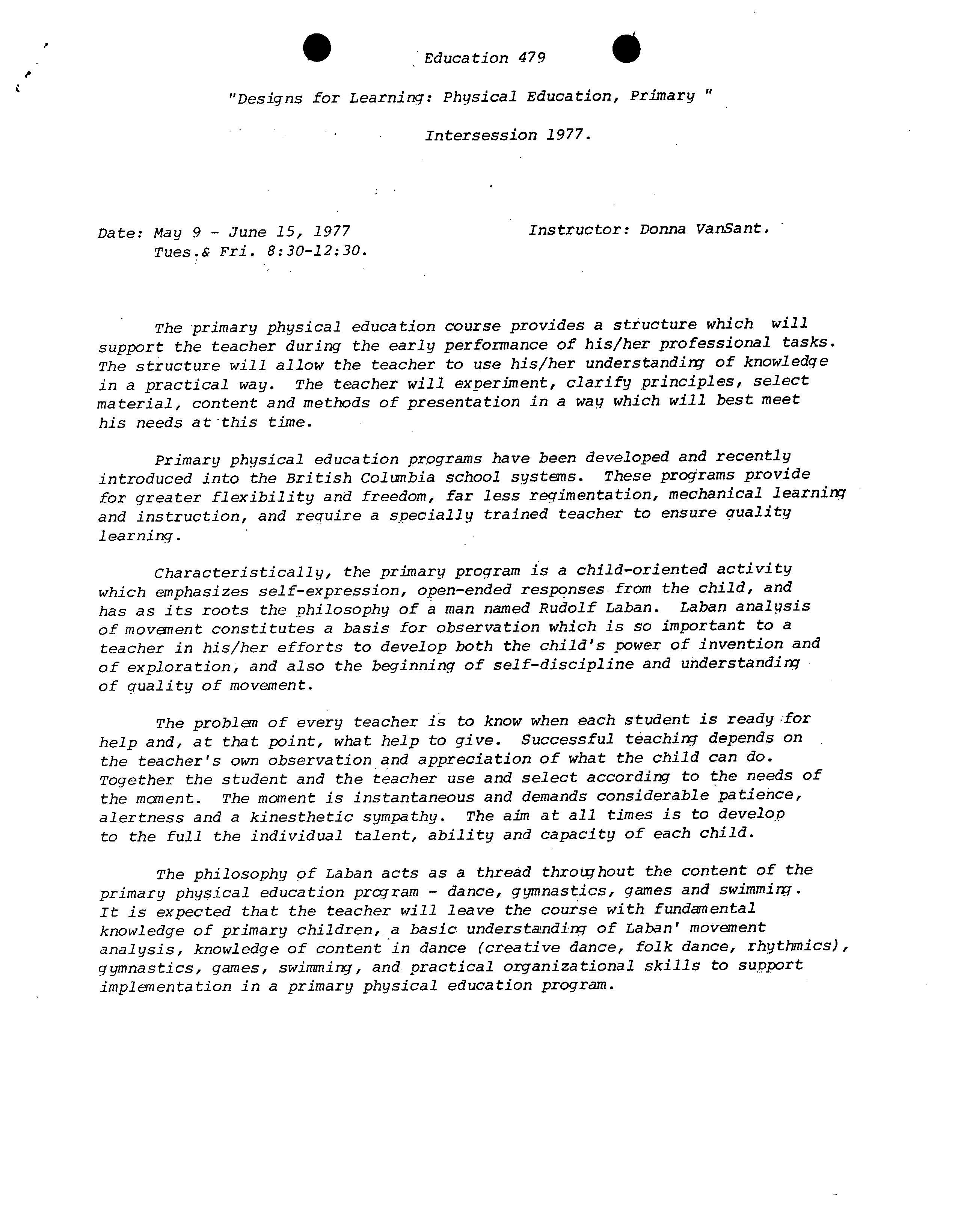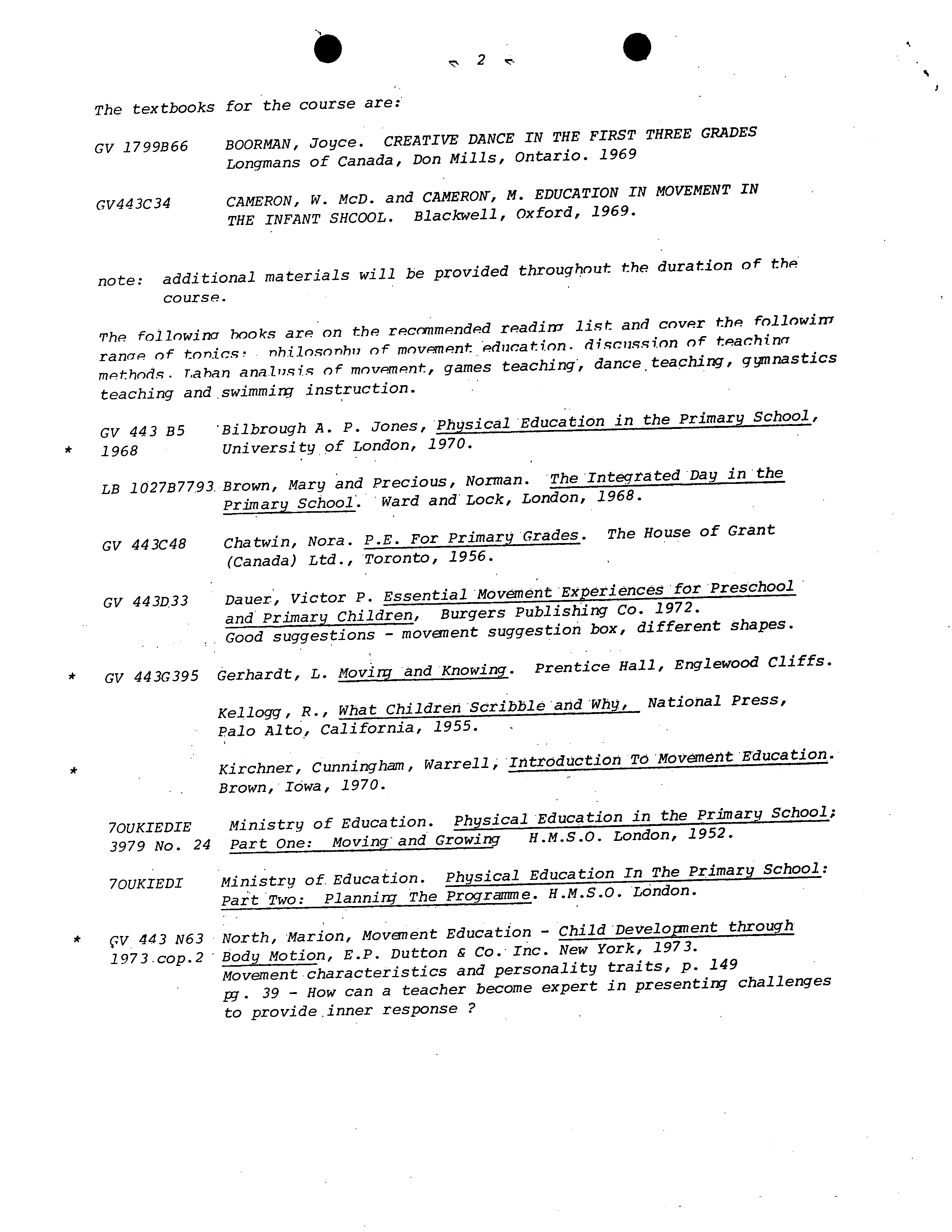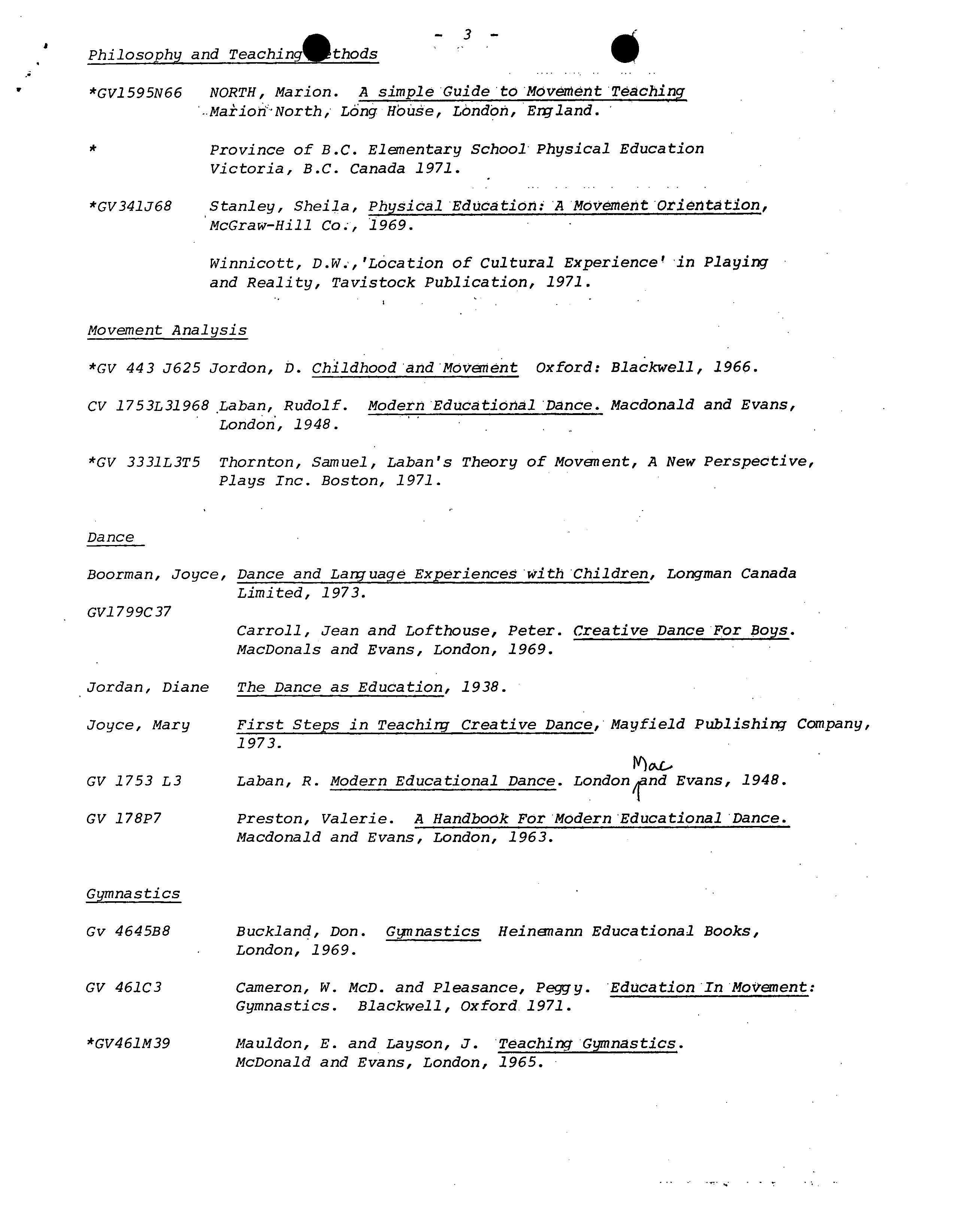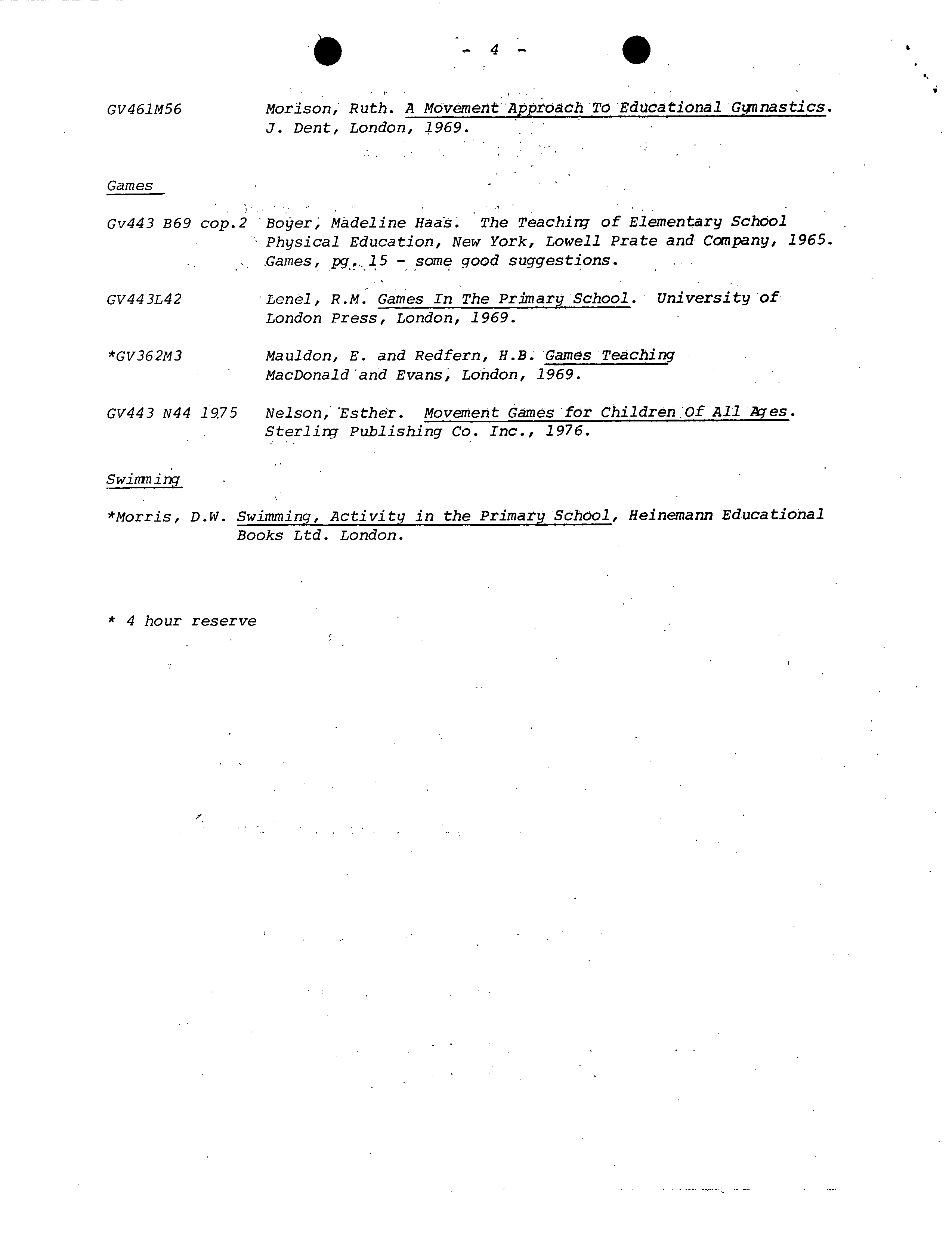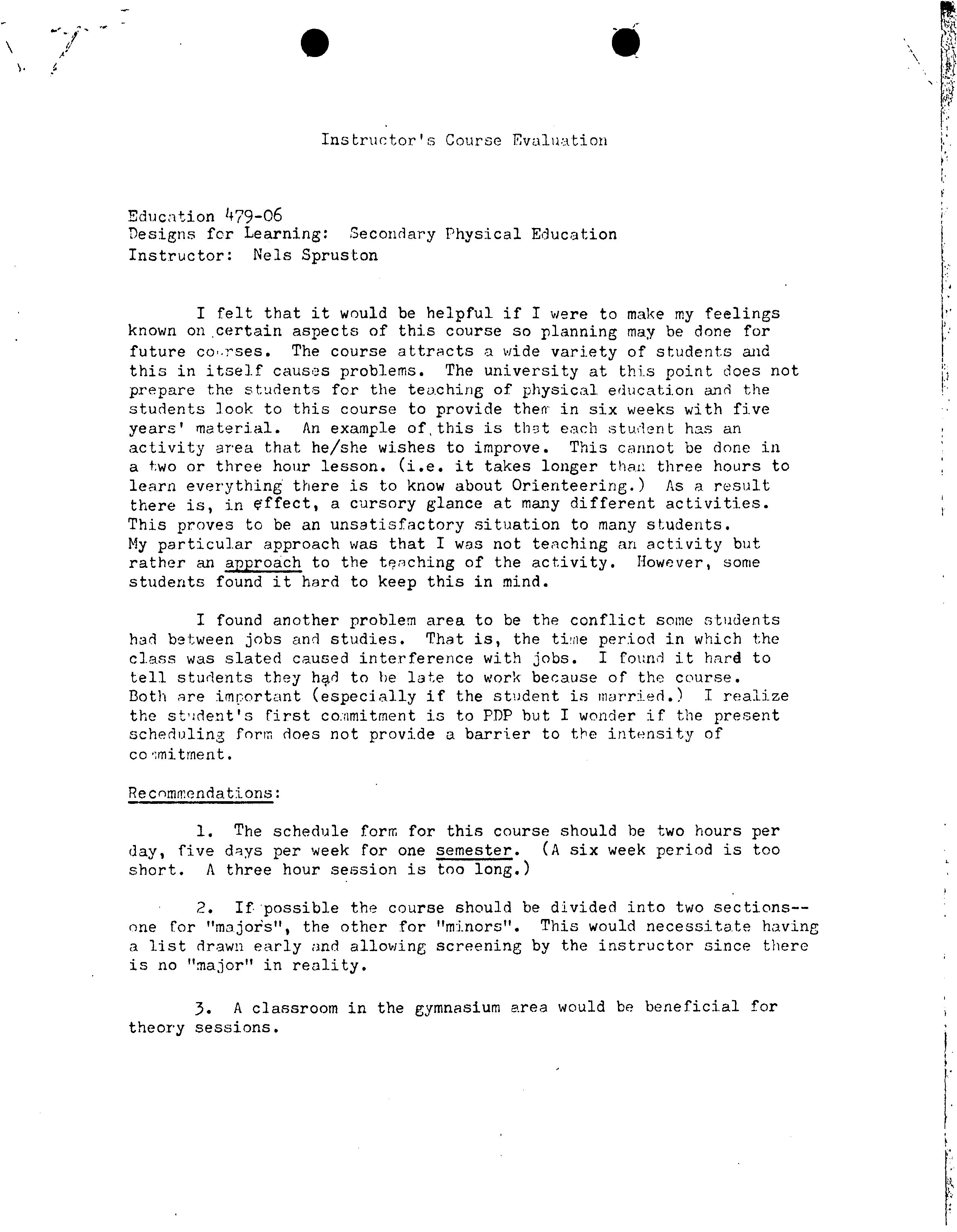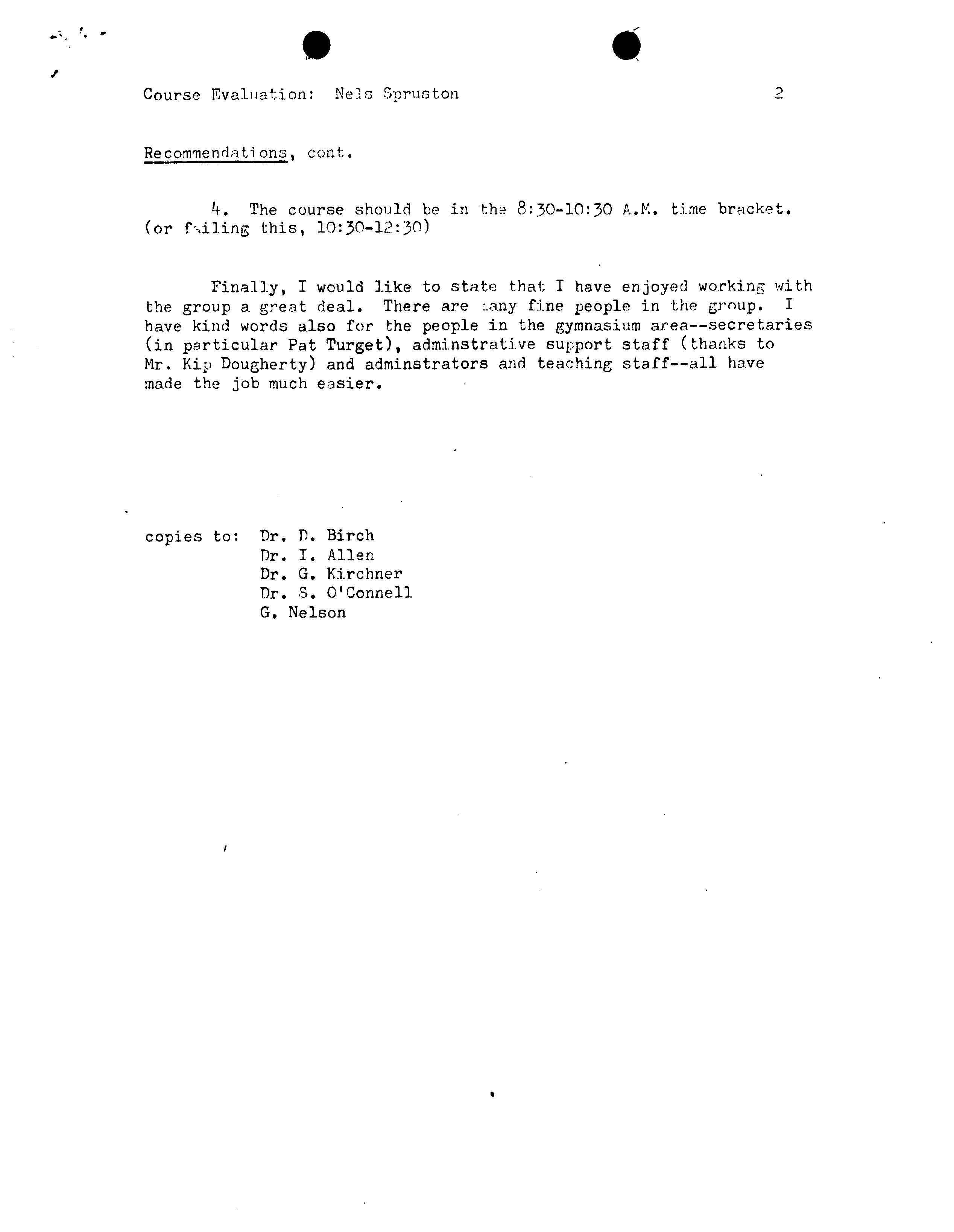S
Education 479
?
0
/
"Designs for Learning: Physical Education, Primary
Intersession 1977.
Date: May 9 - June 15, 1977
?
Instructor: Donna VanSant.
Tues.& Fri. 8:30-12:30.
The primary physical education course provides a structure which will
support the teacher during the early performance of his/her professional tasks.
The structure will allow the teacher to use his/her understanding of knowledge
in a practical way. The teacher will experiment, clarify principles, select
material, content and methods of presentation in a way which will best meet
his needs at this time.
Primary physical education programs have been developed and recently
introduced into the British
Colinbia
school systems. These programs provide
for greater flexibility and freedom, far less regimentation, mechanical learning
and instruction, and require a specially trained teacher to ensure quality
learning.
Characteristically, the primary program is a child-oriented activity
which emphasizes self-expression, open-ended responses from the child, and
has as its roots the philosophy of a man named Rudolf Laban. Laban analysis
of movement constitutes a basis for observation which is so important to a
teacher in his/her efforts to develop both the child's power of invention and
of exploration, and also the beginning of self-discipline and understanding
of quality of movement.
The problem of every teacher is to know when each student is ready ;for
help and, at that point, what help to give. Successful teaching depends on
the teacher's own observation and appreciation of what the child can do.
Together the student and the teacher use and select according to the needs of
the moment. The moment is
instantaneous
and demands considerable patience,
alertness and a kinesthetic sympathy. The aim at all times is to develop
to the full the individual talent, ability and capacity of each child.
The philosophy of Laban acts as a thread throughout the content of the
primary physical education program - dance, gymnastics, games and swimming.
It is expected that the teacher will leave the course with fundamental
knowledge of primary children, a basic understanding of Laban' movement
analysis, knowledge of content in dance (creative dance, folk dance, rhythmics),
gymnastics, games, swimming, and practical organizational skills to support
implementation in a primary physical education program.
S ?
S
The textbooks for the course are:
?
GV 1799B66 ?
BOORMAN, Joyce. CREATIVE DANCE IN THE FIRST THREE GRADES
?
LongmaflS of Canada, Don Mills, Ontario. 1969
GV443C34
?
CAMERON, W. McD. and CAMEROW, M. EDUCATION IN MOVEMENT IN
?
THE INFANT SHCOOL. Blackwell, Oxford, 1969.
note: additional materials will be provided throughout the duration of the
course.
The followina hooks are on the reccrnmended readiz77 list: and cover the followirll
ranae of tonics
?
nhilosonhll of movement education. discussion of teachirl(7
methods. T,ahan .nalij.ci.c of movement, games teaching, dance teaching, gymnastics
teaching and swimmirg instruction.
?
GV 443 B5
?
BilbrOUgh A. P. Jones, Physical Education in the Primary School,
* 1968 ?
University of London, 1970.
LB 1027B77,93 Brown, Mary and Precious, Norman. The Integrated Day in the
Primary School. Ward and Lock, London, 1968.
?
GV 443C48 ?
Chatwin, Nora. P.E. For Primary Grades. The House of Grant
(Canada) Ltd., Toronto, 1956.
?
GV 443D33 ?
Dauer, Victor P. Essential Movement Experiences for preschool
and Primary Children, Burgers Publishing Co. 1972.
Good suggestions - movement suggestion box, different shapes.
* GV 443G395 Gerhardt, L. Moving and Knowing. Prentice Hall, Englewood Cliffs.
Kellogg, R., What Children Scribble andY, National Press,
Palo Alto, California, 1955.
*
?
Kirchner, Cunningham, Warrell, Introduction TO Movement Educati9j.
Brown, Iowa, 1970.
?
70UKIEDIE
?
Ministry of Education. Physical Education in the Primary School;
3979 No. 24 Part One: Movingand Growing H.M.S.O. London, 1952.
?
70UKIEDI
?
Ministry of. Education. Physical Education In The Primary School:
Part Two: Planning The Progratrflne. H.M.S.O. London.
* cv 443 N63 North, Marion, Movei7ent Education - Child DeveloFrfleflt through
1973 cop.2 Body Motion, E.P. Dutton & Co. Inc. New York, 1973.
Movement characteristics and personality traits, P. 149
pg. 39 - How can a teacher become expert in presenting challenges
to provide inner response ?
'I
Philosophy and Teachingthods
?
- ?
I
*GV1595N66 NORTH, Marion. A simple 'Guide 'to 'MOvement 'Teaching
'..MaIioñ North, Lang Hoàse, Làndbh, England.
*
?
Province of B.C. Elementary School Physical Education
Victoria, B.C. Canada 1971.
*GV341J68 ?
Stanley, Sheila, Physical 'Education: 'A 'MOvement 'Orientation,
McGraw-Hill Co;, 1969.
Winnicott, D.W.,'Location of Cultural Experience' 'in Playing
and Reality, Tavistock Publication, 1971.
Movement Analysis
*GV 443 J625 Jordon, D. Childhood'and'Movanent Oxford: Blackwell, 1966.
cv 1753L31968 Laban, Rudolf. Modern 'Educational 'Dance. Macdonald and Evans,
London, 1948.
*GI/ 3331L3T5 Thornton, Samuel, Laban's Theory of Movement, A New Perspective,
Plays Inc. Boston, 1971.
Dance
Boorman, Joyce, Dance and Language Experiences 'With 'Children, Longman Canada
Limited, 1973.
GV1 799C37
Carroll, Jean and Lofthouse, Peter. Creative Dance For Boys.
MacDonals and Evans, London, 1969.
Jordan, Diane The Dance as Education, 1938.
Joyce, Mary
?
First Steps in Teaching Creative Dance,' Ma
y
field Publishing Company,
1973.
GV 1753 L3 ?
Laban, R. Modern Educational Dance. London
,1
and Evans, 1948.
GV 178P7 ?
Preston, Valerie. A Handbook For 'Modern 'Educational 'Dance.
Macdonald and Evans, London, 1963.
Gymnastics
Gv 4645B8 ?
Buckland, Don. Gymnastics Heinemann Educational Books,
London, 1969.
GV 461C3
?
Cameron, W. McD. and Pleasance, Peggy. 'Education'In Movement:
Gymnastics. Blackwell, Oxford. 1971.
*GV461M39 ?
Mauldon, E. and Layson, J. 'Teachiflcj Gymnastics. ?
McDonald and Evans, London, 1965.
.4
GV461M56
?
Morison, Ruth. A MdVemfltApproChTOEducational Gt'nnastics.
J. Dent, London, 1969.
Games
Gv443 B69 cop.2 Boyer, Madeline Haas The Teaching
,
of Elementary SchOol
Physical Education, New York, Lowell Prate and Company, 1965.
Games, pg... 15 - some good suggestions.
?
S
GV443L42 ?
Lenèl, R.M. Games In The Primary School. University of
London Press, London, 1969.
*GV362M3 ?
Mauldon, E. and Redfern, H.B.Games Teaching
MacDonald and Evans; London, 1969.
GV443 N44 1975 Nelson; Esthér. Movement Games for ChildrenOf All Ajes.
Sterlirq Publishing Co. Inc., 1976.
Swimming
*Morris, D.W. Swimming, Activity in the Primary School, Heinemann Educational
Books Ltd. London.
* 4 hour reserve
.
?
.
?
\
Instructor's Course Evaluation
Education
479-06
Designs
for
Learning: Secondary Physical Education
Instructor: Nels Spruston
I felt that it would be helpful if I
were
to make my feelings
known on certain aspects of this course so planning may be done for
future corses. The course attracts a wide variety of students and
this in itself causes problems. The university at this point does not
prepare the students for the teaching of physical education and the
students look to this course to provide them in six weeks with five
years' material. An example of this is th-3t each student has an
activity area that he/she wishes to improve. This cannot be done in
a two or three hour lesson. (i.e. it takes longer than three hours to
learn everything there is to know about Orienteering.) As a result
there is, in qffect, a cursory glance at many different activities.
This proves to be an unsatisfactory situation to many students.
My particular approach was that I was not teaching an activity but
rather an approach to the tnching of the activity. However, some
students found it hard to keep this in mind.
I found another problem area to be the conflict some students
had between jobs and studies. That is, the ti!ne period in which the
class was slated caused interference with jobs. I found it hard to
tell students they had to be late to work because of the course.
Both are imrortant (especially if the student is
married.)
I realize
the stdent's first coamitment is to PDP but I wonder if the present
schedulin, form does not provide a barrier to the intensity of
co 'mitment.
Recommendations:
1.
The schedule form for this course should he two hours per
(lay, five days per week for one semester. (A
six
week period is too
short. A three hour session is too long.)
2. If .
possible the course should be divided into two sections--
one for "majors", the other for "minors". This would necessitate having
a list drawn early and allowing screening by the instructor since there
is no "major" in reality.
3.
A classroom in the gymnasium area would be beneficial for
theory sessions.
. ?
I
Course Eva1iation: Ne
l
l
Spru3ton ?
2
Pecommenc1Ftti ons, cont.
!+.
The course should be in th 8:30-10:30 A.M. time bracket.
(or fiiing this, 10:30-12:30)
Finally, I would like to state that have enjoyed working with
the group a great deal. There are any fine people in the group. I
have kind words also for the people in the gymnasium area--secretaries
(in particular Pat Turget), adminstrative support staff (thanks to
Mr. Kip Dougherty) and adminstrators and teaching staff--all have
made the job much easier.
copies to: Dr. P. Birch
Dr. I. Allen
Dr. G. Kirchner
Dr.
IS.
O'Connell
G. Nelson
/
